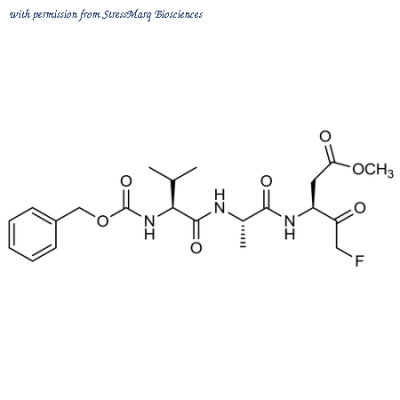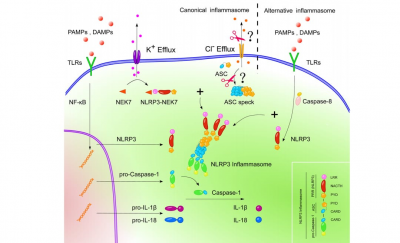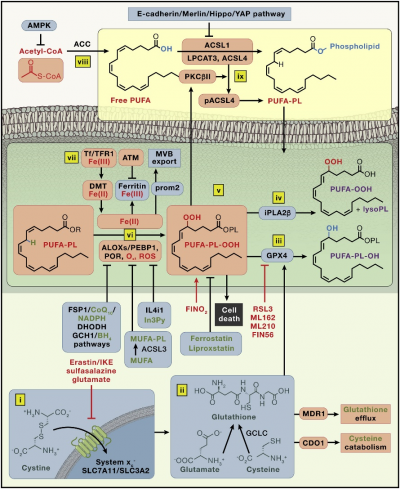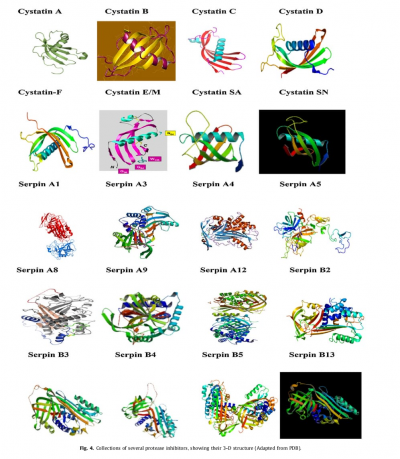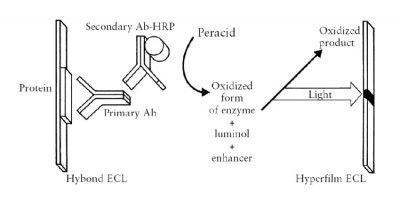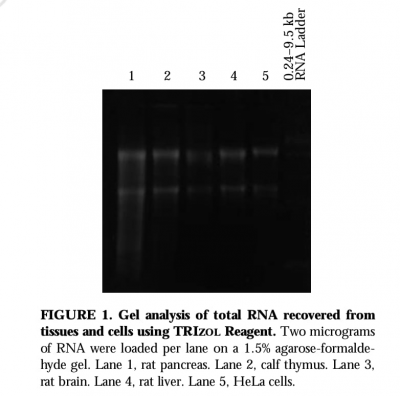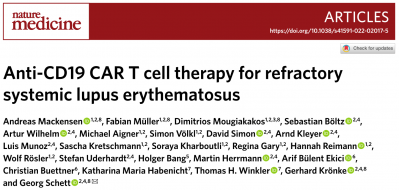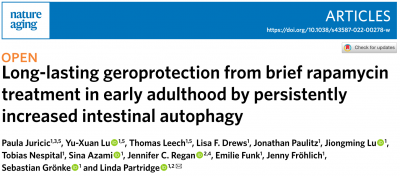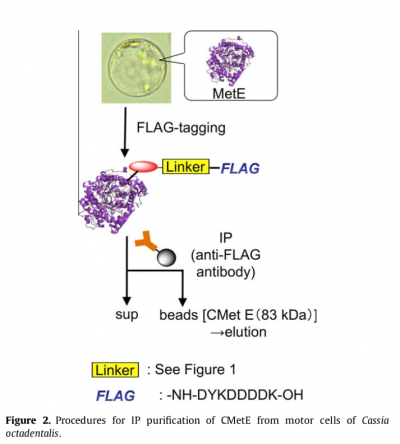Z-VAD-FMK
Z-VAD-FMK, which is referred to as (carbobenzoxy-valyl-alanyl-aspartyl-[O-methyl]- fluoro methyl ketone) is the type of inhibitory molecule that can block the process of apoptosis by inhibiting the caspase enzyme. This caspase inhibitor influences the three types of cellular deaths. First, it can inhibit apoptosis. Moreover, it can also sensitize the cells to undergo necrosis along with the induction of autophagy. Studies also explained the involvement of kinase RIP1, cyclophilin-D complex, and ANT.
MCC950
MCC950 is defined as the specific compound containing diarylsulfonylurea that can be specifically used for the inhibition of the inflammasome by blocking the NLRP3. Inflammasomes are defined as the combination of the multi-protein complex that has a potent role in immunity and inflammation. The major components which are required for the assembly of inflammasome include caspase-1 enzymes, which is a cysteine protease, PRR as a sensor (pattern recognition receptor), and ASC which is defined as the apoptosis-associated CARD. This PRR has three major types of node-like receptors including NLRP1, NLRP3, and NLRC4 along with the AIM2 that are required for the formation of an inflammasome. Among them, NLRP3 inflammasome plays an important role in innate immunity by secreting various kinds of cytokines including IL-1β and IL-18, which triggers the pyroptosis of the cells.
A high-scoring Cell will take you in-depth understanding of the popular direction of scientific research - iron death
Brent R. Stockwell, the author of the origin of the popular research direction of Ferroptosis (ferroptosis), wrote a review of research progress for the 10th anniversary of ferroptosis and published it in the journal Cell with an impact factor of 66.85 (2022). The projects and amounts of the National Natural Science Foundation of China that have won bids in this direction are increasing year by year, and related research papers have repeatedly topped the official CNS journal!
Protease inhibitors cocktail
As we know that the living cell consists of many enzymes. Some of them are protease in nature which can be able to degrade all the proteins within the cell in an uncontrolled manner. These proteases include metalloproteases, aspartic acid proteases, serine proteases, and also are in the form of aminopeptidases. Basically, within the cell, there is protein translation and degradation that occur side by side. The old organelle or proteins which are present within the cells are first degraded with the help of these proteases enzymes into their constituents including amino acids, or peptides. After that these amino acid residues are used by ribosomes for the translation of new proteins.
Ultra-high Sensitivity ECL kit
The ultra-high sensitivity ECL kit is also defined as the electrochemiluminescence kit which is designed to identify a wide variety of antigens. It works on the principle of luminance in which it gives luminance upon the oxidative reaction of luminol in the presence of peroxide and HRP. HRP is called horseradish peroxidase, which in the presence of peroxide, converts luminol into a product that is in oxidized form due to oxidative reaction, giving fluorescence. Then the results of these samples are optimized with the help of any imaging device or any X films. This ultra-high sensitivity ECL kit produces a more uniform and stable color upon a reaction that in return is beneficial to identify low abundant proteins within the sample.
TRIzol reagent
TRIzol reagent is the type of reagent which is widely used by scientists for the complete precipitation of high-quality RNA from cell or tissue samples. Also, it is used to precipitate the volume of DNA and protein from the cells or tissue with great efficiency. It is a monophasic solution that consists of the guanidinium isothiocyanate and phenol within one phase (also called a true homogenous solution) that is used for the denaturation of proteins and the precipitation of the biological materials from the sample. Studies suggest that it is the recently developed method that is generally used for the solubilization and extraction of DNA, RNA, and proteins from cells. Especially this method is more reliable when there is a huge amount of RNase present within the cell or when it is difficult to separate the nuclear RNA from the cytoplasmic RNA in the cell.
Gut-Brain Circuits for Fat Preference
The perception of fat triggers a strong appetite and refinement response. Fat stimulation induces behavioral attraction even in the absence of a functional taste system. The results suggest that fat acts through the gut-brain axis after ingestion to drive fat preference. Using single-cell data, we identified vagal cells that respond to gut fat delivery and showed that genetic silencing of this gut-brain circuit abolished the development of fat preference.
CAR-T is Expected to Cure Systemic Lupus Erythematosus
Systemic lupus erythematosus (SLE) is a life-threatening autoimmune disease characterized by activation of the adaptive immune system, formation of double-stranded DNA autoantibodies, and organ inflammation. Five SLE patients (four women and one man), median (range) age 22 (6) years, median (range) disease duration 4 (8) years, were refractory to several immunosuppressive drugs Active disease (median (magnitude) SLE Disease Activity Index Systemic Lupus Erythematosus Disease Activity Index: 16 (8)) included in the Compassionate Use Chimeric Antigen Receptor (CAR) T-cell program.
Long-lasting geroprotection from brief rapamycin treatment in early adulthood by persistently increased intestinal autophagy
The licensed drug rapamycin has the potential to be repurposed for geriatric protection. A key challenge is avoiding the undesirable side effects of continuous dosing. The findings suggest that the geriatric protective effects of chronic rapamycin treatment can be obtained with brief drug pulses during early adulthood in female flies and mice. In Drosophila, brief early rapamycin treatment in adults extended lifespan and reduced age-related gut decline to the same extent as lifelong administration. Long-lasting memory of early treatment was mediated by enhanced autophagy in enterocytes, accompanied by elevated intestinal LManV and lysozyme levels. The transient elevation of autophagy in early adulthood itself induces a long-term increase in autophagy. In mice, 3 months of early treatment induced memory effects even after 6 months of rapamycin discontinuation, maintaining lysozyme distribution, Man2B1 levels in intestinal crypts, Paneth cells similar to chronic treatment Structure and intestinal barrier function.
3X Flag peptide
Flag peptide is the peptide sequence of amino acids, which is hydrophilic and has high immunogenicity. These are fusion peptides that are used as tags to detect the target molecule either protein or protein complexes for their rapid purification. It is consisting of almost 8 amino acids (DYKDDDDK) which are sequenced in a specific manner. These flag peptides are of small size; hence they are encoded by a short oligonucleotide sequence. Normally the last 5 sequences of amino acids serve as a specific cleavage site of an enzyme called enterokinase, that in turn allows the removal of the tag peptide. Depending upon the functions or applications of the flag peptide, it may either combine with the N or C terminal of the protein. The N-terminal of the given flag peptide has an affinity to bind with the monoclonal antibodies which are called anti-flag antibodies. The complex which is formed between the flag peptide and the monoclonal antibody is Ca2+ dependent. Which can be broken by any chelating agent like EDTA. Some studies contradict this concept by saying that the fusion between the flag peptide and the monoclonal antibodies M1 (Also called anti-flag antibodies) is not Ca2+ dependent.




